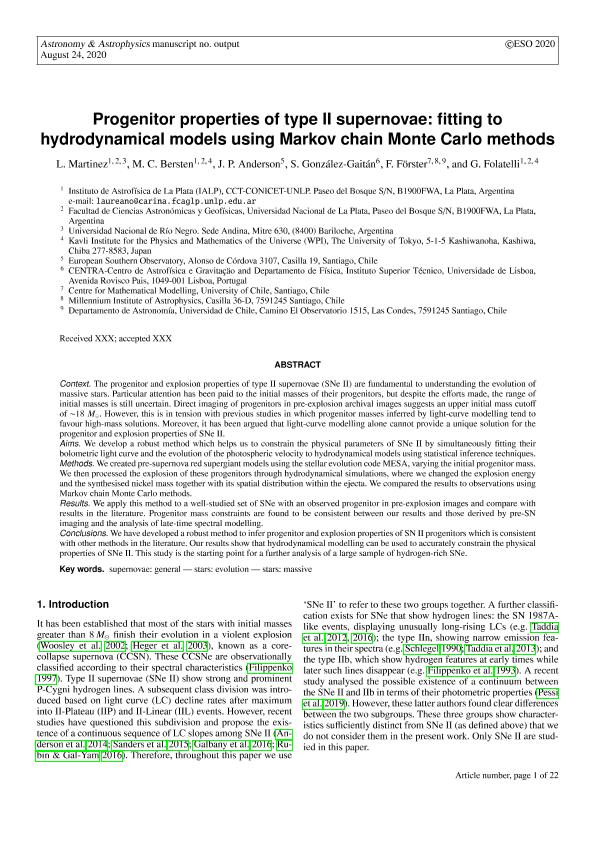Mostrar el registro sencillo del ítem
dc.contributor.author
Martinez, Laureano

dc.contributor.author
Bersten, Melina Cecilia

dc.contributor.author
Anderson, J. P.
dc.contributor.author
González Gaitán, S.
dc.contributor.author
Förster, F.
dc.contributor.author
Folatelli, Gaston

dc.date.available
2021-10-20T14:56:03Z
dc.date.issued
2020-08
dc.identifier.citation
Martinez, Laureano; Bersten, Melina Cecilia; Anderson, J. P.; González Gaitán, S.; Förster, F.; et al.; Progenitor properties of type II supernovae: fitting to hydrodynamical models using Markov chain Monte Carlo methods; EDP Sciences; Astronomy and Astrophysics; 642; A143; 8-2020; 1-21
dc.identifier.issn
0004-6361
dc.identifier.uri
http://hdl.handle.net/11336/144446
dc.description.abstract
The progenitor and explosion properties of type II supernovae (SNe~II) are fundamental to understanding the evolution of massive stars. Particular attention has been paid to the initial masses of their progenitors, but despite the efforts made, the range of initial masses is still uncertain. Direct imaging of progenitors in pre-explosion archival images suggests an upper initial mass cutoff of $\sim$18~\ms. However, this is in tension with previous studies in which progenitor masses inferred by light-curve modelling tend to favour high-mass solutions. Moreover, it has been argued that light-curve modelling alone cannot provide a unique solution for the progenitor and explosion properties of SNe II. We develop a robust method which helps us to constrain the physical parameters of SNe~II by simultaneously fitting their bolometric light curve and the evolution of the photospheric velocity to hydrodynamical models using statistical inference techniques. We created pre-supernova red supergiant models using the stellar evolution code MESA, varying the initial progenitor mass. We then processed the explosion of these progenitors through hydrodynamical simulations, where we changed the explosion energy and the synthesised nickel mass together with its spatial distribution within the ejecta. We compared the results to observations using Markov chain Monte Carlo methods. We apply this method to a well-studied set of SNe with an observed progenitor in pre-explosion images and compare with results in the literature. Progenitor mass constraints are found to be consistent between our results and those derived by pre-SN imaging and the analysis of late-time spectral modelling. We have developed a robust method to infer progenitor and explosion properties of SN II progenitors which is consistent with other methods in the literature. Our results show that hydrodynamical modelling can be used to accurately constrain the physical properties of SNe~II. This study is the starting point for a further analysis of a large sample of hydrogen-rich SNe.
dc.format
application/pdf
dc.language.iso
eng
dc.publisher
EDP Sciences

dc.rights
info:eu-repo/semantics/openAccess
dc.rights.uri
https://creativecommons.org/licenses/by-nc-sa/2.5/ar/
dc.subject
SUPERNOVAE: GENERAL
dc.subject
STARS: EVOLUTION
dc.subject
STARS: MASSIVE
dc.subject.classification
Astronomía

dc.subject.classification
Ciencias Físicas

dc.subject.classification
CIENCIAS NATURALES Y EXACTAS

dc.title
Progenitor properties of type II supernovae: fitting to hydrodynamical models using Markov chain Monte Carlo methods
dc.type
info:eu-repo/semantics/article
dc.type
info:ar-repo/semantics/artículo
dc.type
info:eu-repo/semantics/publishedVersion
dc.date.updated
2021-09-06T17:47:19Z
dc.journal.volume
642
dc.journal.number
A143
dc.journal.pagination
1-21
dc.journal.pais
Francia

dc.journal.ciudad
Paris
dc.description.fil
Fil: Martinez, Laureano. Universidad Nacional de Río Negro; Argentina. Consejo Nacional de Investigaciones Científicas y Técnicas. Centro Científico Tecnológico Conicet - La Plata. Instituto de Astrofísica La Plata. Universidad Nacional de La Plata. Facultad de Ciencias Astronómicas y Geofísicas. Instituto de Astrofísica La Plata; Argentina. Universidad Nacional de La Plata. Facultad de Ciencias Astronómicas y Geofísicas; Argentina
dc.description.fil
Fil: Bersten, Melina Cecilia. Consejo Nacional de Investigaciones Científicas y Técnicas. Centro Científico Tecnológico Conicet - La Plata. Instituto de Astrofísica La Plata. Universidad Nacional de La Plata. Facultad de Ciencias Astronómicas y Geofísicas. Instituto de Astrofísica La Plata; Argentina. Universidad Nacional de La Plata. Facultad de Ciencias Astronómicas y Geofísicas; Argentina
dc.description.fil
Fil: Anderson, J. P.. European Southern Observatory Chile.; Chile
dc.description.fil
Fil: González Gaitán, S.. Centro de Astrofísica E Gravitaçäo; Portugal
dc.description.fil
Fil: Förster, F.. Centro de Modelado Matemático; Chile
dc.description.fil
Fil: Folatelli, Gaston. Universidad Nacional de La Plata. Facultad de Ciencias Astronómicas y Geofísicas; Argentina. Consejo Nacional de Investigaciones Científicas y Técnicas. Centro Científico Tecnológico Conicet - La Plata. Instituto de Astrofísica La Plata. Universidad Nacional de La Plata. Facultad de Ciencias Astronómicas y Geofísicas. Instituto de Astrofísica La Plata; Argentina
dc.journal.title
Astronomy and Astrophysics

dc.relation.alternativeid
info:eu-repo/semantics/altIdentifier/url/https://www.aanda.org/10.1051/0004-6361/202038393
dc.relation.alternativeid
info:eu-repo/semantics/altIdentifier/doi/http://dx.doi.org/10.1051/0004-6361/202038393
Archivos asociados
